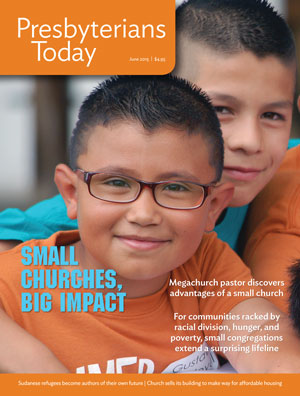 Small churches,
Small churches,
big impact
Though small in size and budget, these congregations are making an enormous impact in their communities.
by Krin Van Tatenhove
It’s evident in nature. Split the atom, and unleash thunderous force. Plant one of the tiniest seeds on earth, and a sequoia arises.
It’s apparent in history. A woman trained in civil rights activism refuses the back of the bus and spawns a movement of justice. A Pakistani girl, gunned down by terrorists, courageously recovers and receives the Nobel Peace Prize.
It’s abundantly clear in Scripture. A stuttering 80-year-old leads his people out of slavery. A shepherd boy defeats a giant. A babe born in a feeding trough becomes the Savior for untold billions, teaching us that the meek will inherit the earth and that faith the size of a mustard grain can move mountains.
It’s a timeless truth: small can be mighty!
In this article you will meet congregations that may be modest in size and budget but are making an enormous impact in their communities.
Of course, not all congregations—small or large—are making a difference. In my 27 years as a Presbyterian pastor serving memberships from 50 to 700, I have seen firsthand how the power of a church’s mission hinges on its answer to two questions: Are we looking inward or outward? Do we concentrate on what we have or what we lack?
Churches of all sizes can become so fixated on their internal ABCs (attendance, buildings, cash) that they lose touch with their habitat. They forget Christ’s call to be incarnational, to put flesh to his love and grace exactly where we are planted.
Churches that understand this commission seek out the “least of these” in their locales. They see global issues, and then address them locally. They unmask idolatries and listen to the voices of people long silenced. They do not gauge the power of their ministry by standard metrics (the ones we report to GA every year) but by lives revived, wounds healed, strangers welcomed, and communities drawn into unity.
These congregations also tend to focus on abundance rather than scarcity. By stepping out in faith, believing that God will send the Spirit and necessary resources, they learn a precious faith lesson. By ourselves we accomplish limited objectives. With God’s help, we can do things we only imagined!
At Emmanuel Presbyterian Church—in the heavily Latino south side of San Antonio—hundreds of people every Thursday morning gather before dawn, rain or shine. They form a line that wraps around the chapel and out to the street. Many of them are on fixed incomes, their meager funds depleted before the end of the month. In partnership with the San Antonio Food Bank, Emmanuel offers supplemental food for their households.
The church, which I formerly pastored, has a membership and budget far below the PC(USA) average. (The average size of a Presbyterian congregation is 171 members; the median size is 87.) But they are touching many lives, and not just through groceries. One of their greatest joys is to see a Spirit-filled process at work. They call it a “holy domino effect.” Those they feed often become volunteers. They meet a faith community who loves and supports them through every trial. They are drawn to worship, some of them for the first time in their lives. Recently, Emmanuel experienced the joy of welcoming them into membership as disciples of Christ.
One of them, away from the church since fleeing Christian legalism in his youth, said this the day he joined: “God knew my loneliness, and through a series of events brought me here to work in the food bank alongside a wonderful group of people. I attended a Sunday service, and you accepted me with open arms. Your loving hearts made me want to be part of this community of faith. Praise God!”
Krin Van Tatenhove is an ordained teaching elder in the Presbyterian Church (U.S.A.) who lives and writes in San Antonio.
‘The bullet will have to go through both of us’
In the wake of a brutal hate crime and amid ongoing strife, Presbyterians seek racial justice and healing in Jasper, Texas.
James Matthews remembers it as if it were yesterday.
It was June 7, 1998, in Jasper, Texas. Three white men attacked an African American named James Byrd. They tied him, fully conscious, to their pickup truck and dragged him three miles until he died. Then they dumped his dismembered body in an African American cemetery.
“I was horrified that any human being would treat another human being this way,” says Matthews, a retired Army colonel and a ruling elder at First Presbyterian Church (FPC) of Jasper.
The brutality thrust Jasper into the national spotlight. Called one of the most heinous hate crimes in US history, Byrd’s lynching led to the passage of the Matthew Shepard and James Byrd Jr. Hate Crimes Prevention Act, which President Obama signed into law on October 28, 2009.
Years passed and FPC remained insular—a shrinking, all-white congregation averaging 17 in worship. The stigma of Byrd’s murder remained in Jasper, as did the racial chasm. Things got worse in 2012 during a bitter political feud over the firing of Jasper’s first African American police chief. In order to remove him, two African American city council members were recalled by the majority white electorate.
It seemed an impossible problem to address, especially for a small church. That is, until last year. During a period of deep soul-searching about its future, FPC discovered a strong call to change its self-identity and become a mission-focused congregation. First and foremost on their hearts was the desire to promote racial reconciliation.
This led to the formation of a nonprofit called Peace Beyond Understanding (PBU) and the hiring of a new pastor, Cyndi Wunder, whose presence is partially underwritten by the Presbyterian Mission Agency’s Small Church Residency Program, which pairs small, underserved congregations with recent seminary graduates. (For more about Wunder and this program, see Emily Enders Odom’s article “An audacious thing” at pcusa.org/news.)
“What now passes for racial peace in Jasper is simply an absence of open conflict,” FPC members declared in the PBU mission statement. “Instead, we seek ‘the peace of God, which surpasses all understanding.’ We will help identify those ready to move beyond racial mistrust and build a healthy, loving, and inclusive community. Our charter is to bring lasting change as people develop authentic relationships across color lines. And it starts person to person.”
“The most common thing I hear from people,” says Wunder, “is that there is so much more to Jasper than the publicized tragedies that have defined us. It’s hard to grow into a new reality. This is our effort to start the process in an authentic way.”
PBU is embryonic, but the congregation and Wunder are proactive on many fronts. They have opened their doors to a Spanish-speaking congregation whose pastor is now on the PBU board. FPC is also are part of the biracial Ministerial Alliance of Jasper. It participates in citywide events promoting racial harmony. Members invite people of other races to worship.
Hill Kemp, a session member and driving force behind PBU, says: “Hearts and minds can change. I grew up in Louisiana as a rabid racist, a legacy of hatred passed on in my family. At every football game, they played ‘Dixie’ like it was our national anthem, hands over our hearts. But in college I intentionally threw all that over and changed my life. I believe God will bless our efforts through PBU and that we will be part of a healing transformation in Jasper.”
Wunder is realistic about the challenges. She points, for instance, to Jasper’s recent Martin Luther King Jr. march. Hundreds of people participated, but only six were white. Of those, four were members of FPC Jasper. And there’s no doubt that the members of FPC will have to confront their own privilege, even as allies, and take care not to seize leadership from communities of color.
Even in the face of such hurdles, PBU believes in Jesus’ parable of the mustard seed, that humble beginnings may bear great fruit. Those seeds were present at FPC from the beginning, as seen in a well-known story about Matthews.
Just days after Byrd’s murder, the African American population of Jasper staged a protest and marched down Main Street, right past Matthews’s home. He was seated on his front porch when he heard the singing and drums beating, so he walked down his driveway. A young girl led the crowd. She turned to Matthews and said, “Join us!” With only a second’s hesitation, he fell into line, coming alongside a tall, muscular man and locking his arm in his. The other man looked at Matthews and said, “You might get us both shot, white man.” Matthews replied, “If that’s true, the bullet will have to go through both of us.”
FPC prays for a day when solidarity occurs without violence or fear, a day that will celebrate Paul’s admonition: “[Christ] has committed to us the message of reconciliation. We are therefore Christ’s ambassadors, as though God were making [God’s] appeal through us” (2 Cor. 5:19–20 NIV).
Where all are pilgrims
After years of membership decline, one congregation is enjoying a renaissance by making contact with the poor through experiential learning projects.
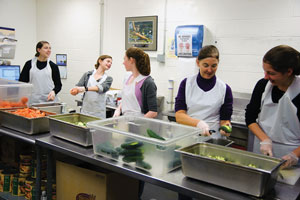
A Pilgrimage group prepares food at a soup kitchen in Washington, DC, as part of a service-learning experience through Church of the Pilgrims.
Adrian Martin led his first Pilgrimage in 2012. His group of teens from Athens, Georgia, will never forget the experience.
“In the capital, there’s an organization that publishes Street Sense, a newspaper written by the homeless,” Martin says. “They sell it during the day, wearing bright green vests. Everyone in DC knows that neon green signifies a homeless person. So this is what our youth did. We put those vests on ourselves and joined in distributing the papers. What we discovered was shocking. People treated us as if we were invisible, looking the other way, even faking calls with upside down cellphones just to act like they were busy.”
Amy Derringer works with Community-Based Learning at the University of North Florida. As part of an alternative spring break, she led a group of college students on their first Pilgrimage last year.
“We were serving breakfast at Charlie’s Place, a DC soup kitchen,” Derringer says. “The leaders suggested we stay afterwards and talk with those who had come in for breakfast. Honestly, many of the volunteers were anxious. ‘What would we have in common?’ I heard someone say. But it turned out to be a wonderful time of sharing. We talked about our favorite scenes in Harry Potter, getting and losing jobs, relationships, hopes, and dreams. It dispelled our preconceived notions about people experiencing homelessness. We simply came together on the basis of our humanity.”
Stories like these are common for the Pilgrimage, a ministry of Church of the Pilgrims, a 100-member congregation in the heart of our nation’s capital. This program began in the early 1970s as a hostel for people wanting to learn about advocacy work. Then it morphed into an urban plunge, a way to expose others to poverty and its systemic causes. As demand grew, it relocated from a small row house to the church’s massive basement. This year they expect to host 90 groups—mostly youth and college-aged—and to transform the lives of thousands.
The program’s design is simple. Participants visit soup kitchens, homeless shelters, urban gardens, food banks, and low-income quadrants of the city. In the evenings, they debrief through small-group exercises and Bible study. It’s a pedagogy of service and reflection.
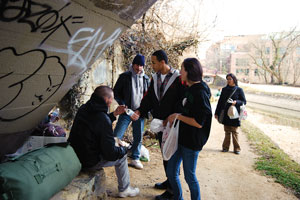
A Pilgrimage group shares bottled water and other necessities with two homeless men in Washington, DC.
One of the humble tasks for volunteers is to prepare a sack containing water and food items. Then they approach a homeless person on the streets, using the offering as an icebreaker. It’s a vulnerable face-to-face encounter.
“This is one of the hardest but most powerful actions,” says Rachel Pacheco, program manager. “It breaks down stereotypes, forcing us to see the broken pieces of our world. It also teaches us that, in the end, we are all just people.”
Pacheco shepherds groups from initial contact until the day they leave DC.
“The most gratifying thing for me is to hear the stories of those who have life-changing experiences,” she says. “Recently, a college student who grew up in the suburbs of DC came here with a service-learning class. It led him to change his major, start a nonprofit, and bring other students to the Pilgrimage to share his experience.”
“Our mission,” she says, “is to stretch perspectives about the root issues of poverty. But it is far more than this. We hope people will return to become advocates for change in their own communities. We now offer grants to help others organize action in their hometowns and colleges.”
Church of the Pilgrims began in 1903 as Second Presbyterian Church. Renamed in 1919, it became a flagship cathedral of the Southern church. During the 1960s, it championed civil rights, exhibiting a devotion to social justice that endures to this day.
Over the years, membership declined, making it hard for the congregation to maintain its towering, elegant facility. But thanks to God and strong leadership, Pilgrims is undergoing a renaissance. It offers a host of creative ministries and has become a certified Earth Care Congregation through Presbyterian Environmental Ministries (pcusa.org/earthcarecongregations). An example is its urban garden, Sacred Greens, where members grow produce used at Open Table, the church’s weekly meal for neighbors in need.
However, the Pilgrimage remains the church’s strongest outreach, providing spiritual vitality and much-needed funds.
And what about the hope that the Pilgrimage will have far-reaching ripple effects? It’s becoming a reality, one group at a time.
Martin, now working with Sardis Presbyterian in Charlotte, North Carolina, looks back on his first trip. “The Pilgrimage changed our hearts forever. When we got home, we sought out the homeless in Athens and engaged them, sharing smiles and conversation with God’s children.”
Derringer received one of the Pilgrimage’s grants. She used it to organize an immersion event in Jacksonville, Florida, raising the consciousness of many about urban poverty in that city.
As Jeff Krehbiel, one of the pastors of Pilgrims, says, “Over the course of the past three decades, we have impacted the lives of thousands of people far beyond the doors of our church.”
Both Martin and Derringer will continue to lead student groups to the Pilgrimage.
“I can’t even put into words how powerful this experience has been for all of us,” says Derringer. “We are going back this year.”
Walk by faith, not by sight
Confronted with an economic recession and a stagnant congregation, Presbyterians risk it all to serve their community and witness to the gospel.
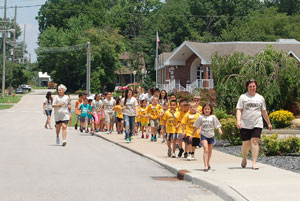 Each week, the Micah Center serves hundreds of people through a cornucopia of programs. Food distribution, meals for children, GED tutoring, domestic violence counseling, and even health screenings and federal and state programming assistance are available under its roof.
Each week, the Micah Center serves hundreds of people through a cornucopia of programs. Food distribution, meals for children, GED tutoring, domestic violence counseling, and even health screenings and federal and state programming assistance are available under its roof.
The 5,400-square-foot building opened this year to house the core ministries of Dale Presbyterian Church in Dale, Indiana, population 1,500. This rural congregation of 48 members is making an impact far beyond its size. Even more remarkable is the story of how it got there.
In 2005, the church was at a crossroads. The community and congregation both were stagnant. The church had called a new pastor, Martha FrizLanger, in 2001 and had long been considering whether or not to move to Santa Claus, a more affluent town nearby. It employed the usual diagnostic tactics—analyzing demographics, budgets, and projections of possible growth or decline.
But FrizLanger suggested a different approach, one birthed from a weekly prayer gathering. The session embraced it.
First, the congregation immersed itself in Scripture. During Lent, members took turns reading the entire Bible—Genesis to Revelation—out loud in the sanctuary. They extended this practice beyond Lent for three years. FrizLanger blogged every day to help members reflect on the text. “I felt there was a deep, unmet hunger for knowing God’s Word,” she says.
The second element was prayer. Members prayed over the buildings and grounds, seeking God’s guidance. They walked the neighborhoods of Dale, interceding for their neighbors.
Finally, they spent quality time with each of the children and youth in the congregation, harvesting their needs and visions for the future.
In 2008, the Great Recession descended, hitting the rural community of Dale particularly hard. As the members of Dale Presbyterian looked around at the needs of their neighbors, God gave them two convictions. First, they would stay and serve exactly where God had planted them. Second, they would build a facility to resource the entire community, calling it the Micah Center.
Toward the end of this process, the church adopted its signature purpose statement, the words of Micah 6:8: “He has told you, O mortal, what is good; and what does the Lord require of you but to do justice, and to love kindness, and to walk humbly with your God?” Members memorized the text. And it became the guide for the church’s reorganized structure of only three committees: the Hands Committee (for doing justice), the Heart Committee (for loving mercy), and the Worship Committee (for walking humbly with God).
With a love for art, FrizLanger offered a way to synthesize their hopes. She fashioned a mural out of canvas and gave each member and child a piece to decorate. “It was wonderful,” she says. “Beyond the colors, some inscribed theirs with words from favorite scriptures or hymns. One man wrote a complete psalm on his, and one girl wrote something that touched all of us: ‘Our Father, who art in heaven, how will I be your name?’ ”
That girl’s prophetic question would soon be answered. “Had we moved our church to Santa Claus, we would have missed our unique calling,” says ruling elder Vicki Winkler. “It was God’s will for us to remain.”
But the challenge to build the Micah Center was daunting.
“I had never fundraised in my life,” says FrizLanger. “I am primarily a creative person. But in my prayers God gave me a distinct message: ‘Martha, you will not build this building. It will be built by the body of Christ.’ I [sent] an email to people I knew who believed in God’s provision, asking them to donate $1 and pass the email to others. Within two weeks, we had $2,000 and a flood of encouraging words. The congregation was amazed!”
That humble beginning blossomed. The church had a successful community banquet to cast its vision. Businesses and individuals got on board. Community partners hosted their own fundraisers. Emails traveled across the globe. Grant requests found favorable reception. Out of the blue, a local architect offered his expertise pro bono.
Within two years, the church and community had raised more than $425,000, three-fourths of the funds needed to construct the Micah Center.
“I think God blessed this mission because it’s a true collaboration, centered on what our neighbors need, not just [what] our church [needs],” says ruling elder Tom Thake. “We see small miracles every day, from people arriving unsolicited with truckloads of food to children in our program saying, ‘This will be my only meal today.’ ”
“The process has strengthened my faith,” says Winkler. “I’m normally optimistic, but now I truly believe that with God all things are possible.”
“We continue to be gratefully shocked by all that is happening,” says FrizLanger. “If I had one thing to say to my Presbyterian brothers and sisters across the nation, it would be this: Quit believing in Jesus; instead believe Jesus—what he says, what he teaches, who he is. Be obedient to his instructions and you will find yourself blessed beyond measure.”
Keeping the sabbath
Finding an eighth day in the week
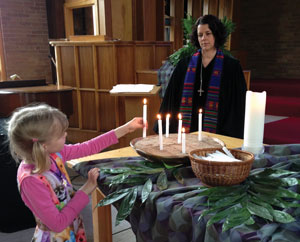
A Lenten worship service this year at Lake Nokomis Presbyterian Church in Minneapolis
In Sabbath as Resistance: Saying No to the Culture of Now, Walter Brueggemann writes: “Sabbath . . . is not about worship. It is about work stoppage. It is about withdrawal from the anxiety system of Pharaoh, the refusal to let one’s life be defined by production and consumption and the endless pursuit of private well-being.”
For Lake Nokomis Presbyterian Church (LNPC) in Minneapolis, Brueggemann’s work stoppage has become more than an idea; it has become a practice.
Seven years ago, this church of 94 members was considering whether or not it could keep its doors open. The people felt that God wasn’t through with them yet, but the question was “Where do we go from here?”
With its new pastor, Kara Root, the congregation entered a season of discernment.
“We began by celebrating, then letting go, of what we were in the past,” says Root. “We also refused to compare ourselves to other congregations, looking instead at our own uniqueness.”
Out of this time, three themes emerged: worship, hospitality, and Sabbath. Together they read Sabbath: Finding Rest, Renewal, and Delight in Our Busy Lives by Wayne Muller. It led to an unorthodox experiment.
They changed their worship schedule to include only two Sundays a month. On the other weekends, they gather for an evening Sabbath service, sharing food, contemplation, and prayer to prepare for their day of rest.
Root explains the underlying idea. “At LNPC, we say that Sabbath does two things: it reminds us ‘whose we are’ and it shows us ‘who we are.’ When we withdraw from a system that defines us mostly by what we produce or consume, we return to our essential belonging in God, the One who calls [us] into freedom and wholeness. This is sometimes intimidating or painful. But in the space it creates, we discover that time stretches out, [that] joy goes deeper, and we gratefully recognize God’s presence in the moments of an ordinary day.”
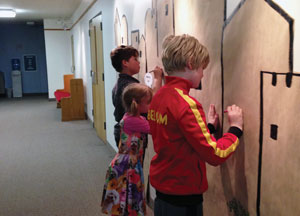
During Lent, the children of the congregation were invited to take a hands-on approach to worship.
To help people remember their purpose, the children of the church created a card with the acronym REST: R (relax), E (enjoy), S (see), and T (take your new insights and awareness into the week).
“Another practice,” says Root, “is to have a piece of paper in the worship bulletin that says two things. First, ‘Today I say yes to . . . .’ What would give me joy and peace and fill me with delight? What do I long for today that connects me to God, myself, and others? Second, ‘Today I say no to . . . .’
What can I stop doing to remember I am free? What worry, task, belief, or practice do I feel owned by? What can I put down so that I [will] recognize I belong to God and not to anything else seeking to dictate my life?”
Members have experienced Sabbath in a rich variety of ways: touring a butterfly exhibit, visiting relatives, taking leisurely walks, baking cookies with a grandchild, reading poetry on the front porch. Some engage in deep conversations, while others experiment with silence and solitude.
Cyndi Wunder (see article on p. 22) says her time at LNPC was seminal to seeking her call as a pastor in the Presbyterian Church (U.S.A.). Sabbath emphasis was part of this.
“Initially, I planned to visit other churches on those [Sabbath] days, but the opportunity to rest in God’s presence—to have nothing required, nothing to do—was simply too attractive. I often sat on park benches watching the squirrels run, sipping a latte, soaking up the sun. Like many people, my life is often hurried. Sabbath Sundays ushered me into a different way of being, a gentle openness to God’s presence. It was delicious, and now I seek to continue this practice, especially when things get hectic.”
Carolyn Cochrane moved with her husband and three children from a large downtown church to LNPC five years ago. They got involved immediately. Carolyn values the intergenerational family at the congregation and its artistry in worship. She calls LNPC “the little church that could.”
“Our Sabbath focus has shown me,” she says, “the need to quiet my distracted mind and listen for that ‘still, small voice.’ It has taught my children that it’s OK to just be and not do. I particularly enjoy our Saturday services. The entire liturgy—from the music to the readings to the message—helps me center myself for the next day. I am grateful to LNPC for helping us in this discipline. It is essential for our continued journeys in relationship to God.”
Kara Root says that Sabbath is like discovering an eighth day in the week. And she is touched by the response of other congregations.
“We frequently get questions about our Sabbath practices. It’s so amazing that this small church—just trying to connect more meaningfully with God—is having an impact far beyond.”


